Summer’s days are fleeting with fall just around the corner, and teachers have returned to their classrooms rejuvenated after vacation days spent recovering from a hard nine months of teaching and then relaxing and recharging their batteries. Sometimes time away from the classroom affords extra time to read books for pleasure and catch up on the latest book award winners. But it also provides teachers with the luxury of uninterrupted time to catch up on some professional reading that might prompt new approaches to literacy instruction or encourage radical changes in how we define literacy. Professional reading might also be the kick-start we need to make simple changes in our daily routines; for instance, spending five minutes on a poem every day or once a week or considering the effects of the CCSS on daily instruction. The International Reading Association (IRA) and other publishers released many insightful texts this year. This week the members of the IRA Children’s Literature and Reading Special Interest Group (CL/R SIG) share our thoughts about some professional texts that caught our attention and nudged us to reflect on our own pedagogy.
Appleman, Deborah, & Graves, Michael F. (2012). Reading better, reading smarter. Portsmouth, NH: Heinemann.
 Although the authors themselves may come from two different disciplines, their recognition that English teachers are also literacy teachers responsible for teaching literature but also responsible for teaching reading led to this book. They propose that teachers use what they call “scaffolded reading experiences” so that students are able to “read successfully, enjoyably, and purposefully” (p. xv). Subsequently, they provide 22 specific activities that support student readers before they read the texts assigned for class, while they read the texts, and after they have completed them. In the book’s six chapters, the authors provide tips for teaching students to use different lenses as they read as well as advice for text selection and how to evaluate student performance. After teachers digest the sample activities provided here, they will be able to create their own similar activities to accompany the texts their students read. Naturally, the authors address issues of motivation, relevance, and building background knowledge throughout the book. Most notable, though, is that the texts for which reading activities have been created are books or short stories with which teachers are already familiar, offering ways to refresh their approaches, as well as some, lesser known texts that promise to provoke rich classroom discussions. Since the books the authors discuss in the text are listed in the back matter, teachers can slowly start to transform their classrooms so that their students learn to become smarter readers.
Although the authors themselves may come from two different disciplines, their recognition that English teachers are also literacy teachers responsible for teaching literature but also responsible for teaching reading led to this book. They propose that teachers use what they call “scaffolded reading experiences” so that students are able to “read successfully, enjoyably, and purposefully” (p. xv). Subsequently, they provide 22 specific activities that support student readers before they read the texts assigned for class, while they read the texts, and after they have completed them. In the book’s six chapters, the authors provide tips for teaching students to use different lenses as they read as well as advice for text selection and how to evaluate student performance. After teachers digest the sample activities provided here, they will be able to create their own similar activities to accompany the texts their students read. Naturally, the authors address issues of motivation, relevance, and building background knowledge throughout the book. Most notable, though, is that the texts for which reading activities have been created are books or short stories with which teachers are already familiar, offering ways to refresh their approaches, as well as some, lesser known texts that promise to provoke rich classroom discussions. Since the books the authors discuss in the text are listed in the back matter, teachers can slowly start to transform their classrooms so that their students learn to become smarter readers.
- Barbara A. Ward, Washington State University Pullman
Bromley, Karen. (2012). The next step in vocabulary instruction: Practical strategies and engaging activities that help all learners build vocabulary and deepen comprehension. New York: Scholastic.
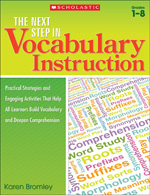 Former IRA board member Karen Bromley has written a very practical book filled with ideas that teachers can use to help their students approach new words independently. In a teacher-friendly manner she masterfully weaves cutting-edge research into her text to build a strong rationale for each strategy and activity while addressing the following questions:
Former IRA board member Karen Bromley has written a very practical book filled with ideas that teachers can use to help their students approach new words independently. In a teacher-friendly manner she masterfully weaves cutting-edge research into her text to build a strong rationale for each strategy and activity while addressing the following questions:
- How can I become a word-conscious and wise vocabulary teacher?
- How can I teach in ways that help students become independent word learners?
- How can I develop and deepen the vocabulary of struggling students and English language learners?
- How can I promote electronic and online word learning via the Internet?
- How can I build my students’ enjoyment of language through wordplay?
- How can I use children’s literature to build word knowledge and language appreciation?
Each chapter provides ideas for direct instruction, guided practice, and independent learning. Teachers will find this an excellent resource for enriching students’ vocabularies across the curriculum.
- Terrell A. Young, Brigham Young University Provo
Calkins, Lucy, Ehrenworth, Mary, & Lehman, Christopher. (2012). Pathways to the Common Core: Accelerating achievement. Portsmouth, NH: Heinemann.
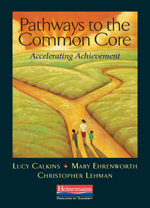 In this useful book that could serve as a primer for the latest education reform movement, the authors explain exactly what the Common Core State Standards (CCSS) are and how they are impacting what is taught in schools today as well as how what is taught is being assessed. After addressing the criticisms of naysayers as well as the laudatory remarks of supporters of the CCSS, they provide some suggestions as to how to implement the Standards within the existing structure of classrooms. The book contains eleven chapters intended to demystify the Standards themselves and possible pedagogical applications. After providing an overview of the CCSS for Reading, the authors examine Standards 1 and 10 Literal Understanding and Text Complexity. Chapter 4 and 5 look at Standards 2-9 with their emphasis on Reading Literature and Reading Informational Texts. Chapter 6 provides an overview of the Writing Standards with more specificity offered in the next chapters. Chapter 7 hones in on Composing Narrative Texts, Chapter 8 discusses composing Argument Texts, and Chapter 9 looks at Composing Informational Texts. Chapter 10 focuses on Speaking and Listening and Language Standards, and the final chapter ties up loose ends, reminding teachers of the link between assessment and instruction. While the book may not make readers into proponents of the CCSS, it certainly does clarify many points while also acknowledging that the route to this particular change is not clear. The book is not intended as a blueprint or a roadmap that must be followed assiduously, but it does provide a place for teachers to begin examining their instruction and a way to begin conversations about curriculum. This is essential reading for today’s teachers and would be a perfect book for a teacher book club.
In this useful book that could serve as a primer for the latest education reform movement, the authors explain exactly what the Common Core State Standards (CCSS) are and how they are impacting what is taught in schools today as well as how what is taught is being assessed. After addressing the criticisms of naysayers as well as the laudatory remarks of supporters of the CCSS, they provide some suggestions as to how to implement the Standards within the existing structure of classrooms. The book contains eleven chapters intended to demystify the Standards themselves and possible pedagogical applications. After providing an overview of the CCSS for Reading, the authors examine Standards 1 and 10 Literal Understanding and Text Complexity. Chapter 4 and 5 look at Standards 2-9 with their emphasis on Reading Literature and Reading Informational Texts. Chapter 6 provides an overview of the Writing Standards with more specificity offered in the next chapters. Chapter 7 hones in on Composing Narrative Texts, Chapter 8 discusses composing Argument Texts, and Chapter 9 looks at Composing Informational Texts. Chapter 10 focuses on Speaking and Listening and Language Standards, and the final chapter ties up loose ends, reminding teachers of the link between assessment and instruction. While the book may not make readers into proponents of the CCSS, it certainly does clarify many points while also acknowledging that the route to this particular change is not clear. The book is not intended as a blueprint or a roadmap that must be followed assiduously, but it does provide a place for teachers to begin examining their instruction and a way to begin conversations about curriculum. This is essential reading for today’s teachers and would be a perfect book for a teacher book club.
- Barbara A. Ward, Washington State University Pullman
Fletcher, Ralph. (2011). Mentor author, mentor texts. Portsmouth, NH: Heinemann.
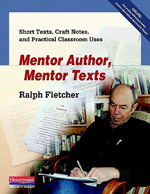 Savvy teachers realize that there is a strong link between reading and writing. If student writers hear and read examples of good writing--texts that can serve as mentors for their own writing--they are likely to become better writers. In this book, the author provides 24 pieces of his own for teachers to use as mentor texts in writing instruction. There are stories, poems, essays, picture books, novel excerpts, and memoirs among the selections, some short, some longer. The author includes his own writer’s notes about each text so that student writers can peek inside his thinking process and follow along in understanding his own writing decisions. For some pieces, he points out specific things he wants young writers to notice while essentially opening the text and the creative process for them. There are also places in which the author explains his revision process and shows some of the revisions he made on these published pieces, something that will reassure beginning writers since they may expect their own writing to need no revision. Not only does the author provide materials to teach writing, allowing his own writing to serve as an example, but he explains how this book can be used in the classroom, complete with testimonies from teachers who offer their suggestions about where it might fit within a mini-lesson on as the focus of one aspect of writing, in a writer’s workshop or unit on writing. Best of all, readers will have the chance to marvel at Fletcher’s own writing while also learning ways to bring it and his craft into their own classrooms.
Savvy teachers realize that there is a strong link between reading and writing. If student writers hear and read examples of good writing--texts that can serve as mentors for their own writing--they are likely to become better writers. In this book, the author provides 24 pieces of his own for teachers to use as mentor texts in writing instruction. There are stories, poems, essays, picture books, novel excerpts, and memoirs among the selections, some short, some longer. The author includes his own writer’s notes about each text so that student writers can peek inside his thinking process and follow along in understanding his own writing decisions. For some pieces, he points out specific things he wants young writers to notice while essentially opening the text and the creative process for them. There are also places in which the author explains his revision process and shows some of the revisions he made on these published pieces, something that will reassure beginning writers since they may expect their own writing to need no revision. Not only does the author provide materials to teach writing, allowing his own writing to serve as an example, but he explains how this book can be used in the classroom, complete with testimonies from teachers who offer their suggestions about where it might fit within a mini-lesson on as the focus of one aspect of writing, in a writer’s workshop or unit on writing. Best of all, readers will have the chance to marvel at Fletcher’s own writing while also learning ways to bring it and his craft into their own classrooms.
- Barbara A. Ward, Washington State University Pullman
Laminack, Lester L. and Wadsworth, Reba M. (2012). Bullying Hurts: Teaching kindness through read alouds and guided conversations. Portsmouth, NH: Heinemann.
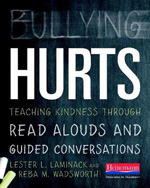 The authors introduce this important book by describing several incidences of bullying that might surprise readers and then offer a rationale for a book that seeks to address bullying through literature and discussion. They write, "We believe focused read aloud experiences with carefully selected children's literature followed by guided conversations is one way you can create a climate in your classroom, school, or district where bullying is not an accepted or rewarded behavior. A climate where an individual's humanity and human dignity trump any difference(s) and kindness is the order of the day" (p. xii). Using the Common Core State Standards as connections to the read aloud selections chosen for this book, the authors explain how the use of read aloud experiences starting from the first day of kindergarten and continuing through the elementary years will develop a framework to help children understand bullying. Looking at character analysis, comprehension strategies, reflection techniques and critical thinking and problem solving strategies, teachers can guide critical thinking discussions about bullying with young and emerging readers. The book’s seven chapters discuss commonalities and differences and offer ways to change bullying behavior. Back matter also includes activities to build community and resources for teachers. Teachers will want to learn more about one of the authors through his website. See CL/R SIG reviews K-12 books about bullying here.
The authors introduce this important book by describing several incidences of bullying that might surprise readers and then offer a rationale for a book that seeks to address bullying through literature and discussion. They write, "We believe focused read aloud experiences with carefully selected children's literature followed by guided conversations is one way you can create a climate in your classroom, school, or district where bullying is not an accepted or rewarded behavior. A climate where an individual's humanity and human dignity trump any difference(s) and kindness is the order of the day" (p. xii). Using the Common Core State Standards as connections to the read aloud selections chosen for this book, the authors explain how the use of read aloud experiences starting from the first day of kindergarten and continuing through the elementary years will develop a framework to help children understand bullying. Looking at character analysis, comprehension strategies, reflection techniques and critical thinking and problem solving strategies, teachers can guide critical thinking discussions about bullying with young and emerging readers. The book’s seven chapters discuss commonalities and differences and offer ways to change bullying behavior. Back matter also includes activities to build community and resources for teachers. Teachers will want to learn more about one of the authors through his website. See CL/R SIG reviews K-12 books about bullying here.
- Karen Hildebrand, Ohio Library and Reading Consultant
Newkirk, Thomas. (2012). The art of slow reading. Portsmouth, NH: Heinemann.
 In today’s highly-distracting world and amid today’s rush to insure that all students are proficient readers, able to handle increasingly complex texts and types of text, this book touts the merits of reading more slowly. The author suggests that there is something to be said about savoring text rather than rushing to the book’s end. By slow reading, the author has in mind “the relationship we have with what we read, with the quality of the attention that we bring to our reading, with the investment we are willing to make” (p. 2). In an age where there are so many distractions and calls on our time, the author is concerned that everything moves too fast for much appreciation of the writer’s craft or for ideas to be digested. To his way of thinking, readers who slow down are able to hear the voice of authors and appreciate the way sentences flow while those who read too quickly may miss the writer’s craft. Consequently, he provides six ways to slow reading down: performing, memorizing, centering, problem finding, reading like a writer, and elaborating. The book’s eight chapters are filled with ways in which students—and their teachers—can adjust their reading pace and sip, rather than gulp, the nourishment found in the books they read. Reading should not be something that is timed for speed but an experience that allows the words being encountered to have some effect on those who are reading them. Consider reading this way to be akin to water gently bubbling from a fountain contrasted with a tsunami of words. What a brave and inspiring counterpoint to the current rush toward skimming and finishing everything quickly!
In today’s highly-distracting world and amid today’s rush to insure that all students are proficient readers, able to handle increasingly complex texts and types of text, this book touts the merits of reading more slowly. The author suggests that there is something to be said about savoring text rather than rushing to the book’s end. By slow reading, the author has in mind “the relationship we have with what we read, with the quality of the attention that we bring to our reading, with the investment we are willing to make” (p. 2). In an age where there are so many distractions and calls on our time, the author is concerned that everything moves too fast for much appreciation of the writer’s craft or for ideas to be digested. To his way of thinking, readers who slow down are able to hear the voice of authors and appreciate the way sentences flow while those who read too quickly may miss the writer’s craft. Consequently, he provides six ways to slow reading down: performing, memorizing, centering, problem finding, reading like a writer, and elaborating. The book’s eight chapters are filled with ways in which students—and their teachers—can adjust their reading pace and sip, rather than gulp, the nourishment found in the books they read. Reading should not be something that is timed for speed but an experience that allows the words being encountered to have some effect on those who are reading them. Consider reading this way to be akin to water gently bubbling from a fountain contrasted with a tsunami of words. What a brave and inspiring counterpoint to the current rush toward skimming and finishing everything quickly!
- Barbara A. Ward, Washington State University Pullman
Owocki, Gretchen. (2012). The Common Core lesson book, K-5: Working with increasingly complex literature, informational text, and foundational reading skills. Portsmouth, NH: Heinemann.
 This very practical and teacher-friendly book is a “must have” resource for teaching the Common Core State Standards in K-5 classrooms. For each standard, Owocki begins by placing the standards in the context of meaningful, research-based best practices. She provides teachers with a clear description of each standard and helps them see what each standard expects from students. Moreover, teachers are able to make note of grade expectations so that they know the expectations for students in the grades before and after their own. For each anchor standard, Owocki provides teachers with guidelines and strategies to teach the standard through the gradual release of responsibility model that includes teacher demonstration, collaborative engagement, and independent application. She even provides prompts at various grade levels for teachers to use. Moreover, the instructional decision trees included in the text effectively connect assessment to planning and provide teachers with additional techniques for intensifying instruction for readers needing additional support. Classroom teachers especially will appreciate the many graphic organizers for student use. This book is the ideal tool for helping teachers in enhancing and extending adopted curricula to meet the CCSS goals.
This very practical and teacher-friendly book is a “must have” resource for teaching the Common Core State Standards in K-5 classrooms. For each standard, Owocki begins by placing the standards in the context of meaningful, research-based best practices. She provides teachers with a clear description of each standard and helps them see what each standard expects from students. Moreover, teachers are able to make note of grade expectations so that they know the expectations for students in the grades before and after their own. For each anchor standard, Owocki provides teachers with guidelines and strategies to teach the standard through the gradual release of responsibility model that includes teacher demonstration, collaborative engagement, and independent application. She even provides prompts at various grade levels for teachers to use. Moreover, the instructional decision trees included in the text effectively connect assessment to planning and provide teachers with additional techniques for intensifying instruction for readers needing additional support. Classroom teachers especially will appreciate the many graphic organizers for student use. This book is the ideal tool for helping teachers in enhancing and extending adopted curricula to meet the CCSS goals.
- Terrell A. Young, Brigham Young University Provo
Silvers, Penny and Shorey, Mary C. (2012). Many texts, many voices: Teaching literacy and social justice to young learners in the digital age. Portland, ME: Stenhouse.
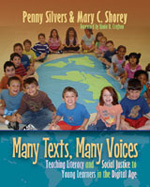 The book’s authors collaborated in a college classroom and an elementary school classroom in order to explore critical literacy and critical thinking. The book enables them to share ideas and activities with other teachers interested in implementing critical literacy concepts developed around the ideas of social justice to children. They comment, "Critical literacy requires that the reader/consumer examine multiple perspectives and ask, 'Whose interests are being served?' and 'Whose voice is heard—or silenced?' (p. 12). Rather than an addition to a lesson or curriculum, critical literacy is a way of thinking, communicating, analyzing, and living a literate life. Critical literacy also implies the possibility of taking some kind of social action in order to support a belief, make a difference, or simply help during a time of need." This professional book offers teachers specific books to use, lesson guides for implementation, assessment tools, text set lists, student checklists, graphic organizers, diagrams, technology tools, a detailed index and more. In addition to the plethora of reading ideas, the authors go a step further in the call for action to guide students to become involved in the support and/or aid of people and causes not only within their local communities but also in a global perspective. Using literature as a starting point, they guide students into the stages of critical thinking and evaluating possibilities for action and then to develop the plan of action to conclusion. Their suggestions and lesson ideas for embedding the concepts of social justice into each of these lessons in an authentic format is accurately expressed in the Foreword by Dr. Linda K. Crafton, “By using the twenty-first century multimodal tools of learning, they show explicitly how teachers can bring curriculum to life by grounding the daily experiences of their students in authentic questions that thrill kids the most."
The book’s authors collaborated in a college classroom and an elementary school classroom in order to explore critical literacy and critical thinking. The book enables them to share ideas and activities with other teachers interested in implementing critical literacy concepts developed around the ideas of social justice to children. They comment, "Critical literacy requires that the reader/consumer examine multiple perspectives and ask, 'Whose interests are being served?' and 'Whose voice is heard—or silenced?' (p. 12). Rather than an addition to a lesson or curriculum, critical literacy is a way of thinking, communicating, analyzing, and living a literate life. Critical literacy also implies the possibility of taking some kind of social action in order to support a belief, make a difference, or simply help during a time of need." This professional book offers teachers specific books to use, lesson guides for implementation, assessment tools, text set lists, student checklists, graphic organizers, diagrams, technology tools, a detailed index and more. In addition to the plethora of reading ideas, the authors go a step further in the call for action to guide students to become involved in the support and/or aid of people and causes not only within their local communities but also in a global perspective. Using literature as a starting point, they guide students into the stages of critical thinking and evaluating possibilities for action and then to develop the plan of action to conclusion. Their suggestions and lesson ideas for embedding the concepts of social justice into each of these lessons in an authentic format is accurately expressed in the Foreword by Dr. Linda K. Crafton, “By using the twenty-first century multimodal tools of learning, they show explicitly how teachers can bring curriculum to life by grounding the daily experiences of their students in authentic questions that thrill kids the most."
- Karen Hildebrand, Ohio Library and Reading Consultant
Vardell, Sylvia M. (2012). The poetry teacher’s book of lists. Seattle: CreateSpace.
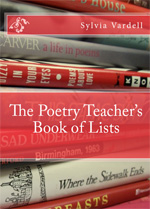 If you are looking for one book to help improve your teaching of poetry, then this is the one for you! This book is a treasure trove containing over 155 different lists and featuring over 1,500 books of poetry for children and teens. Interested in award-winning poetry or books of poetry considered notable? This book contains 27 of those lists. Vardell has also includes 19 holiday and seasonal poetry booklists, 7 multicultural and international poetry booklists, 6 thematic or topical poetry booklists, 21 poetry booklists across the curriculum, 20 booklists highlight the form of poetry, 19 booklists for creating a poetry-friendly environment, 12 lists for sharing and responding to poetry out loud, 15 lists of teaching poetry writing resources, and 9 general poetry teaching resources. She also includes a poetry glossary, prompts to guide meaningful discussions about poetry, a poetry history timeline, blogs for children, blogs for teachers, and so much more. It would be hard to imagine a better resource for teachers and librarians. Anyone anxious about including poetry in the classroom will have all fears alleviated by this thorough book.
If you are looking for one book to help improve your teaching of poetry, then this is the one for you! This book is a treasure trove containing over 155 different lists and featuring over 1,500 books of poetry for children and teens. Interested in award-winning poetry or books of poetry considered notable? This book contains 27 of those lists. Vardell has also includes 19 holiday and seasonal poetry booklists, 7 multicultural and international poetry booklists, 6 thematic or topical poetry booklists, 21 poetry booklists across the curriculum, 20 booklists highlight the form of poetry, 19 booklists for creating a poetry-friendly environment, 12 lists for sharing and responding to poetry out loud, 15 lists of teaching poetry writing resources, and 9 general poetry teaching resources. She also includes a poetry glossary, prompts to guide meaningful discussions about poetry, a poetry history timeline, blogs for children, blogs for teachers, and so much more. It would be hard to imagine a better resource for teachers and librarians. Anyone anxious about including poetry in the classroom will have all fears alleviated by this thorough book.
- Terrell A. Young, Brigham Young University Provo
Vardell, Sylvia, & Wong, Janet. (Compilers). (2012). The Poetry Friday anthology: Poems for the school year with connections to the Common Core, K-5 Edition. Princeton: Pomelo Books.
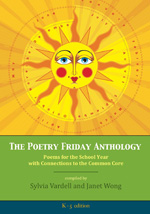 If there is one thing most teachers seem to be afraid to teach, it has to be poetry. Well, they need fear no more, thanks to this wonderful new poetry anthology put together by two former members of the NCTE Award for Excellence in Poetry for Children Committee. This visually-appealing collection features 218 original poems written by 75 poets specifically for the anthology. Arranged by grade level, from kindergarten to fifth grade, the book features one poem on each page as well as poetic connections to the Common Core State Standards. Each poem has a "Take 5!" section with many suggestions about how to perform each poem, including simple props, and ideas about how to introduce poetry to children. The compilers have even provided references to poems or other poetry books with similar themes so that if students love one type of poem or one subject for a poem, they can easily find another similar one in this book or in another volume of poetry. Back matter includes a mini-glossary of poetry terms and a list of 25 websites and blogs devoted to children's poetry. There are memorable poems from some of the stalwarts of this type of writing: Arnold Adoff, Nikki Grimes, Julie Larios, J. Patrick Lewis, Jack Prelutsky, Laura Purdie Salas, Eileen Spinelli, Janet Wong, and Jane Yolen. While many of the poems feature familiar names, verses by others, such as Guadalupe Garcia McCall and Amy Ludwig VanDerwater, show that the future of poetry is in good hands. Be careful when reading this highly-addictive anthology. You may find yourself nodding vigorously in agreement at a poet’s sentiments about a topic or chortling in glee. Find a place for this book on your desk since you’ll be turning to it time and time again. You may even want two copies, one for your students and one for your own use.
If there is one thing most teachers seem to be afraid to teach, it has to be poetry. Well, they need fear no more, thanks to this wonderful new poetry anthology put together by two former members of the NCTE Award for Excellence in Poetry for Children Committee. This visually-appealing collection features 218 original poems written by 75 poets specifically for the anthology. Arranged by grade level, from kindergarten to fifth grade, the book features one poem on each page as well as poetic connections to the Common Core State Standards. Each poem has a "Take 5!" section with many suggestions about how to perform each poem, including simple props, and ideas about how to introduce poetry to children. The compilers have even provided references to poems or other poetry books with similar themes so that if students love one type of poem or one subject for a poem, they can easily find another similar one in this book or in another volume of poetry. Back matter includes a mini-glossary of poetry terms and a list of 25 websites and blogs devoted to children's poetry. There are memorable poems from some of the stalwarts of this type of writing: Arnold Adoff, Nikki Grimes, Julie Larios, J. Patrick Lewis, Jack Prelutsky, Laura Purdie Salas, Eileen Spinelli, Janet Wong, and Jane Yolen. While many of the poems feature familiar names, verses by others, such as Guadalupe Garcia McCall and Amy Ludwig VanDerwater, show that the future of poetry is in good hands. Be careful when reading this highly-addictive anthology. You may find yourself nodding vigorously in agreement at a poet’s sentiments about a topic or chortling in glee. Find a place for this book on your desk since you’ll be turning to it time and time again. You may even want two copies, one for your students and one for your own use.
- Barbara A. Ward, Washington State University Pullman
Also, IRA's new and forthcoming book list includes: